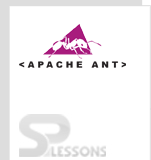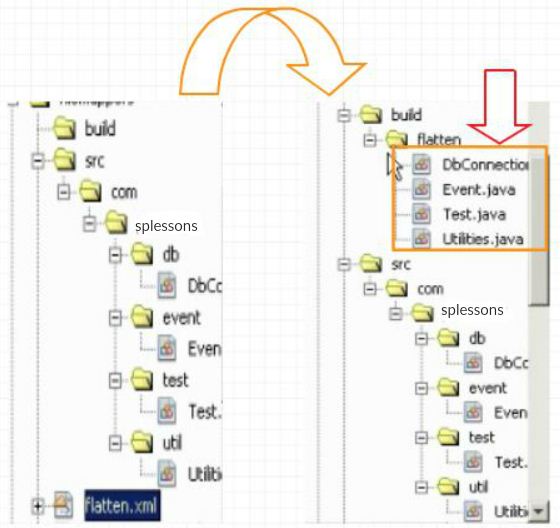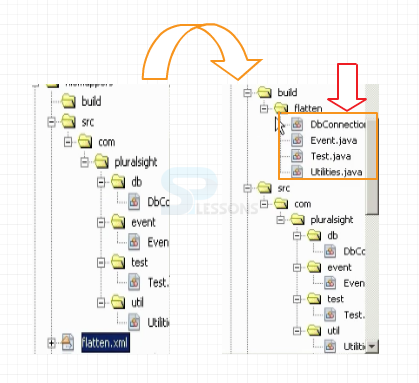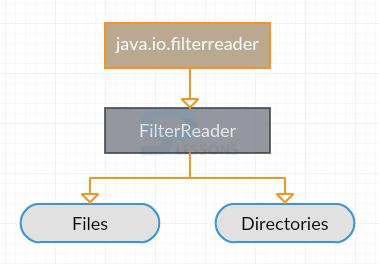 Introduction
Introduction
ANT Elements are not similar to the ANT Tasks. These ANT Elements are also called as datatypes. But, they differ from the data types in programming languages.
The following topics will be covered in Apache ANT Elements chapter:
- DIRSet
- FileSet
- FileList
- FileMapper
- FileReader
- Selector
- Paths
 Description
Description
PatternSets brings the directories or files together. It has three different wild card characters.
The above characters can be grouped together in various ways.
| Character | Description |
|---|---|
| ? | Matching single character. |
| * | Matching zero or more characters |
| ** | Matching zero or more characters in directory structure. |
 Examples
Examples
[java]
<patterset id=”classes”>
<include name=”**/*.class”/>
<exclude name=”**/*Test*.class”/>
</patternet>
[/java]
The above patternset element is nested. This can be written as below by changing the name to includes or excludes:
[java]
<patternset id=”classes” includes=”**/*.class” excludes=”**/*Test*.class”/>
[/java]
 Description
Description
DIRSet is the Directory set. It applies various patterns to the directory structure by taking in some directories and removing other directories.
 Examples
Examples
The below example uses the patternset.
[java]
<dirset dir="build">
<patternset id="classes">
<include name="**/classes"/>
<exclude name="**/*Test*"/>
<patternset>
</dirset>
[/java]
The below example uses include and exclude elements.
[java]
<dirset dir="build">
<include name="**/classes"/>
<exclude name="**/*Test*"/>
</dirset>
[/java]
The following example has include and exclude parameters within the element.
[java]
<dirset dir="build">
<includes="**/classes"
<excludes="**/*Test*"/>
</dirset>[/java]
 Description
Description
FileSet is similar to the DIRSet. However, fileset will not select the directories instead it selects the group of files depending on patterns. In the above example, FileSet adds defaultexcludes parameter and is set to yes, the default state. Then the common files like CVS files, backup files and temp files will be excluded.
 Examples
Examples
[java]
<fileset dir="build" defaultexcludes="yes">
<patternset id=”source”>
<include name="**/*.java" />
<exclude name="**/*Test*" />
</patternset>
</fileset>
[/java]
The below example uses include and exclude elements.
[java]
<fileset dir="build" defaultexcludes="yes">
<include name="**/*.java" />
<exclude name="**/*Test*" />
</fileset>
[/java]
The following example has the include and exclude parameters within the FileSet element.
[java]
<fileset dir="build" defaultexcludes="yes" includes="**/*.java" excludes="**/*Test*" />
[/java]
 Description
Description
FileList selects specific files using the parameters list in which parameters are separated by comma. FileList does not depend on patterns. To refer the files anywhere, assign ref id attribute. While referring to these files, firstly the directory attribute points to the directory and then the files get located.
 Examples
Examples
[java]
<filelist id=”source” dir=”src” files=”SysConfig.java, IConstants.java, Encrypt.java” />
[/java]
 Description
Description
FileMapper copies or removes the files and renames the files in a process. Six types of FileMappers are there in ANT.
 Types
Types
| FileMapper | Description |
|---|---|
| identity | Target filename is identical to the source filename. |
| flatten | Directory structure is flattened. |
| merge | Target filename is same for all source files. |
| glob | Glob matching used on files. |
| regexp | Regular expression matching used on files. |
| package | Based on Java package of source files. |
 Examples
Examples
The below code gives the example for FileMapper's flatten mapper.
[java]
<?xml version="1.0" encoding="UTF-8"?>
<project name="Filemapper flatten example" default="flatten" basedir=".">
<target name="flatten">
<copy todir="build/flatten">
<mapper type="flatten" />
<fileset dir="src">
<include name="**/*.java" />
</fileset>
</copy>
</target>
</project>
[/java]
When the above is run, the following output appears by copying the java files to the build directory irrespective of the directory structure.
The structure will be as follows.
 Description
Description
Java.io.filterreader is the super class for FilterReader. It reads and filters the data. If a number of FilterReaders are grouped as a chain, it is referred as the FilterChain.
 More Info
More Info
There are various types of FilterReaders, they are:
| FileReader | Description |
|---|---|
| stripjavacomments | Removes comments in .java files |
| striplinecomments | Removes user-defined comments. |
| striplinebreaks | Removes end-of-lines characters. |
| classconstants | Output names/value pairs of constants in class files. |
| replacetokens | Replaces tokens within files. |
| tabstospaces | Replaces tabs with given number of spaces. |
| headfilter | Returns the top given number of lines. |
| tailfilter | Returns the bottom given number of lines. |
| linecontains | Copies only lines containing a given string. |
| linecontainsregexp | Copies only lines matching a regexp. |
| prefixlines | Adds a string to the beginning of every line. |
| expand properties | Expands ANT Properties. |
 Examples
Examples
stripjavacomments.xml
[java]
<?xml version="1.0" encoding="UTF-8"?>
<project name="Strip java comments" default="strip" basedir=".">
<target name="strip">
<copy todir="build/stripjava">
<filterchain>
<stripjavacomments />
</filterchain>
<fileset dir="src">
<include name="**/*.java" />
</fileset>
</copy>
</target>
</project>
[/java]
DbConnection.java in src directory can be as follows.
[java]
/**
* Handles all connections to the database
* @version 1.0
* @Today@
*/
package com.splessons.db;
/**
*Establishes a connection to the database
*@author splessons
*/
public class DbConnection {
/**
*Establishes a connection to the database
*@author splessons
*/
public void connect() {
}
}[/java]
When the stripjavacomments.java is made to run again, the following output appears in the build file by filtering all the comments.
[java]
package com.splessons.db;
public class DbConnection {
public void connect() {
}
}[/java]
Likewise, remaining filters can be implemented.
 Description
Description
Selectors help in selecting the files based on various factors.
File selection done by date selector depends on the modification date. In the below example, java files will be selected and modified after the given date.
[java]
<!-- date example -->
<fileset dir="${src.dir}" includes="**/*.java">
<date datetime="01/01/2014 12:00 AM" when="after"/>
</fileset>
[/java]
Present attribute selects both the versions or only a single version in the below example.
[java]
<!-- present example -->
<fileset dir="${v2.src.dir}" includes="**/*.java">
<present present="srconly" targetdir="${v1.src.dir}"/>
</fileset>
[/java]
Size attributes selects files by taking the size into consideration. In the below example, only files below 1k are selected.
[java]
<!-- size example -->
<fileset dir="${src.dir}" includes="**/*.java">
<size value="1" units="Ki" when="less" />
</fileset>
[/java]
The selection criteria for contains attribute is the string presence.
[java]
<!-- contains example -->
<fileset dir="${src.dir}" includes="**/*.java">
<contains text="TODO" casesensitive="no"/>
</fileset>
[/java]
Contains Regular Expression checks for the regular expression.
[java]
<!-- containsregexp example -->
<fileset dir="${doc.path}" includes="*.txt">
<containsregexp expression="[4-6]\.[0-9]"/>
</fileset>
[/java]
The selection criteria for depends is-it selects the files that are modified more recently.
[java]
<!-- depend example -->
<fileset dir="${ant.1.5}/src/main" includes="**/*.java">
<depend targetdir="${ant.1.4}/src/main"/>
</fileset>
[/java]
 Description
Description
Selectors can be combined in various ways using and, not, or and none.
The below example combines the date and size attributes using the and attribute.
[java]<!-- and example -->
<fileset dir="${src.dir}" includes="**/*.java">
<and>
<size value="4" units="Ki" when="more"/>
<date datetime="01/01/2001 12:00 AM" when="before"/>
</and>
</fileset>
[/java]
The below example demonstrates or attribute and selects the files depending on the file type. It takes any of the three formats.
[java]
<!-- or example -->
<fileset dir="${image.dir}">
<or>
<filename name="*.png"/>
<filename name="*.gif"/>
<filename name="*.jpg"/>
</or>
</fileset>
[/java]
Not attribute selects the java files that do not contain text test in them.
[java]
<!-- not example -->
<fileset dir="${src.dir}" includes="**/*.java">
<not>
<contains text="test"/>
</not>
</fileset>
[/java]
None in the below example selects only the java files which don’t have equivalent files present in the destination directory.
[java]
<!-- none example -->
<fileset dir="${src.dir}" includes="**/*.java">
<none>
<present targetdir="${dest.dir}"/>
</none>
</fileset>
[/java]
 Description
Description
ClassFileSet root elements defines the root classes and files on which these root classes depends.
 Examples
Examples
[java]
<?xml version="1.0" encoding="UTF-8"?>
<jar destfile="tools.jar">
<fileset refid="reqdClasses"/>
</jar>
<classfileset id="reqdClasses" dir="${classes.dir}">
<rootfileset dir="${classes.dir}" includes="com/splessons/tools/Util*.class"/>
</classfileset>
[/java]
 Description
Description
Classpaths and paths are important in any programming language. ANT makes setting of paths much more easier by using path types. The path can be defined using ref id when used in other tasks. One can make the nested paths. By doing that, an extra jar file will be added to the first class path.
 Examples
Examples
[java]
<?xml version="1.0" encoding="UTF-8"?>
<project name="Paths Example" default="compile" basedir=".">
<target name="init">
<path id="classpath">
<pathelement path="{$servlet.dir}/servlet.jar" />
<pathelement path="{$javamail.dir}/mail.jar" />
<fileset dir="{$lib.dir}">
<include name="**/*.jar" />
</fileset>
</path>
</target>
<target name="compile" depends="init">
<javac srcdir="src" destdir="build">
<classpath>
<path refid="classpath" />
<pathelement path="${xalan.jar}" />
</classpath>
</javac>
</target>
</project>
[/java]
 Description
Description
Listeners are the user defined custom tasks. There are 7 events that take the help of Listeners.
Loggers depend on listeners and extend the capability of listeners. There are 9 types of loggers.
- Build started
- Build finished
- Target started
- Target finished
- Task started
- Task finished
- Message Logged
| Logger | Description |
|---|---|
| DefaultLogger | Prints the target names. |
| No BannerLogger | Prints the information if special loggings. |
| TimestampedLogger | Similar to default logger but adds timestamp with today’s date and time. |
| BigProjectLogger | This has very large build and sub-projects. It prints the boundaries between starting and ending of each project. |
| SimpleProjectLogger | This is same as the BigProjectLogger, which does the same except more in style of no banner logger with less output. |
| ProfileLogger | Same as the big project logger but prints the boundaries for tasks also. |
| AnsiColorLogger | Output color codes is given by this logger. |
| MailLogger | Success and failure messages are automatically sent to email by capturing all logged output. |
| Log4jListener | This sends the output as log4j events. |
| XmlLogger | Output is given in the XML format. |
 Key Points
Key Points
- PatternSets groups files or directories using ?,* or **.
- ANT Elements DIRSet takes in only the required directories.
- FileSet makes file grouping based on the patterns.
- ref id is used by FileList to locate the required file.
- FileMapper copy/remove and renames the files.
- FilterReader filters the data.
- ClassFileSet defines the root classes.
- Loggers depend on listeners and extend the capability of listeners.






